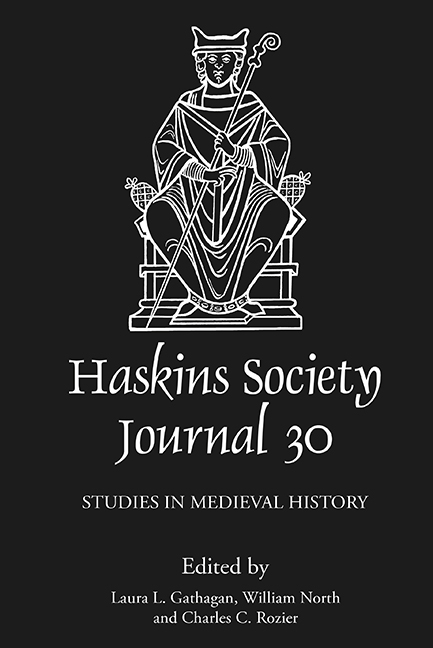Book contents
- Frontmatter
- Contents
- List of Figures and Tables
- Editor's Note
- Abbreviations
- 1 Beyond Corfe: Ælfthryth's Roles as Queen, Villain, and Former Sister-in-law
- 2 Medieval Curses and Their Users
- 3 ‘Although He Was His Nephew’: A Study of Younger Hautevilles Either Side of the Sea
- 4 Nearly Gold and Nearly Perfect? Copper, Meaning, and Materiality in Norman Sicily
- 5 Bound by Loyalty: Conflict, Communication and Group Solidarity in Early Twelfth-Century Southern Italy
- 6 Hugh of Lincoln and Adam of Eynsham: Angevin Kingship Reconsidered
- 7 Earthly Kings, Heavenly Jerusalem: Ralph Niger's Political Exegesis and the Third Crusade
- 8 ‘Holy Christendom's New Colony’: The Extraction of Sacred Matter and the Colonial Status of the Latin Kingdom of Jerusalem
- 9 Medieval French Peasants: The New Frontier?
3 - ‘Although He Was His Nephew’: A Study of Younger Hautevilles Either Side of the Sea
Published online by Cambridge University Press: 30 April 2020
- Frontmatter
- Contents
- List of Figures and Tables
- Editor's Note
- Abbreviations
- 1 Beyond Corfe: Ælfthryth's Roles as Queen, Villain, and Former Sister-in-law
- 2 Medieval Curses and Their Users
- 3 ‘Although He Was His Nephew’: A Study of Younger Hautevilles Either Side of the Sea
- 4 Nearly Gold and Nearly Perfect? Copper, Meaning, and Materiality in Norman Sicily
- 5 Bound by Loyalty: Conflict, Communication and Group Solidarity in Early Twelfth-Century Southern Italy
- 6 Hugh of Lincoln and Adam of Eynsham: Angevin Kingship Reconsidered
- 7 Earthly Kings, Heavenly Jerusalem: Ralph Niger's Political Exegesis and the Third Crusade
- 8 ‘Holy Christendom's New Colony’: The Extraction of Sacred Matter and the Colonial Status of the Latin Kingdom of Jerusalem
- 9 Medieval French Peasants: The New Frontier?
Summary
From the late tenth century to the end of the eleventh a force of warriors from France, primarily but not exclusively Norman, conquered southern Italy and Sicily. Among them the Hautevilles, descendants of an obscure Cotentin knight, were the most successful kin group. While they are best known for a few particularly notorious members, such as Robert Guiscard or Roger II, first king of Sicily, the large clan counted among its branches numerous comital families. The Hautevilles became counts of Loritello, Loreto, Principato, Catanzaro and Conversano, the upper crust of the southern Italian Norman aristocracy, and their kin relations make for a fascinating study of the southern Normans and their conquest strategies. Added to the breadth of the Hauteville kin group is the impressive range of theatres in which their interests played: having reached southern Italy in the 1030s they expanded into Sicily, which was entirely conquered by the 1090s, and established dominions in Outremer with the founding of the principality of Antioch during the First Crusade. The swift ascent of the Hautevilles, who achieved de facto overlordship of the Mezzogiorno by the 1070s, may also be a result of their flexibility regarding inheritance practices. When no children were born to inherit their titles and cooperate in their enterprises they turned to alternate lines of relation. In this, they were hardly alone. When examining the southern Italian Norman aristocracy of the 1150s Errico Cuozzo reflected on their ‘horizontal conception of kinship’ that was suited to a context in which there were few people among whom to divide numerous titles in a constantly embattled landscape. This encouraged the Norman nobility to make extensive use of all available relatives to make up for the shortfall.
This made for a uniquely suitable environment for the development of contextual ad hoc solutions for the building and exploitation of kin networks, as shown throughout the available textual sources. The wealth of material concerning the Normans in the South, consisting of several full-length chronicles, such as the Ystoire de li Normant of Amatus of Montecassino or the extensive Chronicle of Montecassino, and numerous cartularies, several of which have been edited for some time, allow the researcher a broad scope in which to examine Norman family structures in the South.
- Type
- Chapter
- Information
- The Haskins Society Journal 302018. Studies in Medieval History, pp. 53 - 78Publisher: Boydell & BrewerPrint publication year: 2020



